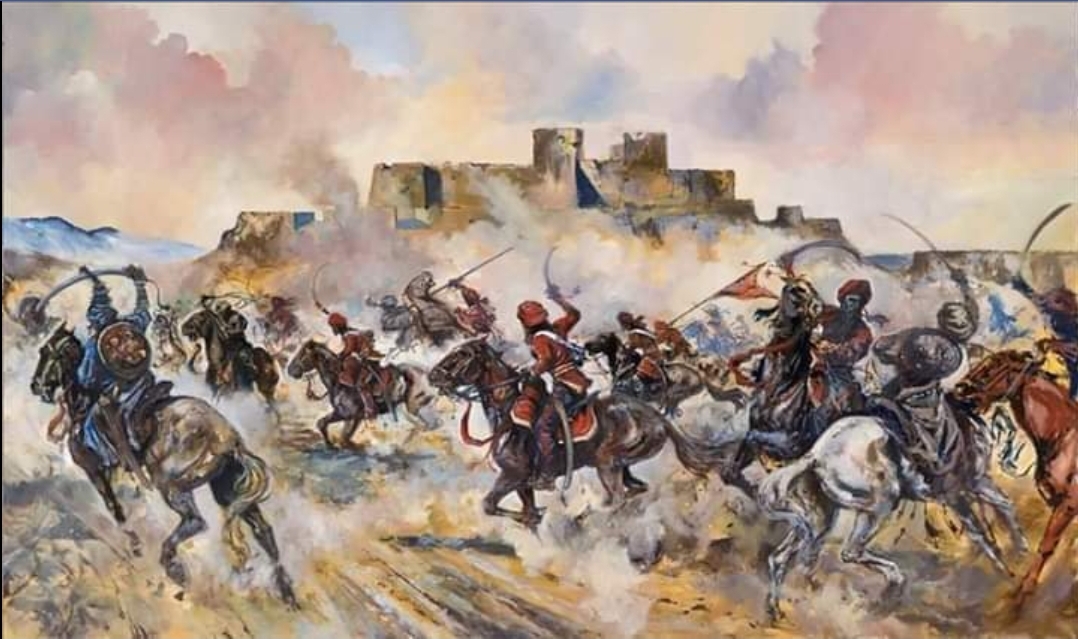In the beginning of 1837, the Maharaja and all his courtiers got fully busy in the preparations of Maharaja’s grandson Prince NauNihal Singh’s marriage. Hari Singh Nalwa was left with a small force and was instructed to build a fort al Jamrud at the mouth of Khyber Pass. Mihan Singh was put in charge with 600 troops. Hari Singh Nalwa lived at Peshawar in the new fortress built on the site of old Bala Hisar.
Amir Dost Muhammad Khan considered the Jamrud fort a great threat to his kingdom. Finding the Maharaja too busy at Lahore, he collected his best troops to attack Jamrud. 7000 horses, 2,000 matchlockmen and 9,000 guerrilla fighters, under his sons Muhammad Akbar Khan and Muhammad Afzal Khan and his Wazir Mirza Sami Khan. About 20,000 Ghazi tribesmen joined them. On 10 March, Hari Singh Nalwa sent a letter informing the Maharaja that Dost Muhammad Khan had reached Jalalabad in order to attack Peshawar. He requested for immediate help. Nalwa was told that after the departure, Sir Henry Fane, the British Commander-in-Chief (who had come for the wedding) troops would be sent to him. On 21 April 1837, another letter was received from Hari Singh. It stated that Afghans had crossed the Khyber Pass, and had entrenched themselves 3 km from Jamrud fort between Jamrud and Peshawar. The Maharaja ordered NauNihal Singh, Allard, Court, Avitabile, , Atariwalas, Sultan Muhammad Khan and Pir Muhammad Khan, marching at a breakneck speed, to reach Peshawar in 5 days, 500 km distant.
Another letter of Hari Singh Nalwa was received on 28 April. It said Afghans were carrying on an incessant shower of cannon balls upon the walls of the fort of Jamrud and had completely demolished one side of the wall of the fort. Mihan Singh, keeper of the fort, continued firing from inside the fort and killed about 500 Afghans. The water channel had been cut off and there was no water in the fort of Jamrud to repair the wall. Hari Singh Nalwa sent 500 water carriers with water skins. The 29th April 1837 Hari Singh Nalwa left for Jamrud with 6000 foot, 1,000 regular cavalry, 3,000 irregulars, and 20 pieces of artillery.
Early in the morning on 30 April 1837, Hari Singh Nalwa began a heavy cannonade. He then feigned a retreat. It drew the whole Afghan army from hill sides into the plain below. The Najib battalion opened fire upon the Afghans. Nalwa pushed Afghans and they begin to retreat. A fresh Afghan force from Ali Masjid drove the Sikhs back. Nalwa was struck by two balls, one in the stomach and the other in the side. He was immediately taken inside the fort. Before dying Hari Singh instructed the troops to remain loyal to Mihan Singh and steadfast in the battle of Jamrud and keep secret the news of his death.
In 1836, the Sikhs had erected a fort at Shabqadar situated to the north of Peshawar. It commanded the Gandab road next to Khyber Pass in importance. Maharaja Ranjit Singh Cousin Sardar Lahna Singh Sandhanwalia of Raja Sansi was in charge of it with 1,500 men. During the battle of Jamrud a diversion was planned by Mirza Sami Khan, Wazir of Kabul, Haji Khan Kakar and Alam Khan attacked it, but they were repulsed.
An engagement took place between the Sikhs and Muhammad Akbar Khan. In the first onslaught the Afghans were driven off the field into the defiles of the Khyber hills leaving behind their guns. The Sikh cavalry 3000 in number, pursued them into the narrow Khyber Pass. Only four horsemen could ride abreast through the Pass. The Sikh horsemen had gone 3.5 km into the Pass. Akbar Khan was with only 100 Afghan horsemen. A fresh force from Ali Masjid joined him. The Sikhs were overwhelmed. Many of them were killed and wounded. At the mouth of the Pass the Sikh infantry checked Akbar Khan’s progress. His horse received three musket balls and three bayonet wounds and had one of its hind legs broken by a ball. The animal fell. All the Afghan soldiers also fell likewise. Akbar Khan managed to escape.
In the second assault Mihan Singh’s brother Jawahar Singh was killed. Mihan Singh put the corpses of Hari Singh and Jawahar Singh in the same coffin. declaring it to be of his brother and cremated them. “In this act”, said the Maharaja, “he showed an example of rare courage”. Just then. General Allard arrived there with reinforcements. At the sight of fresh arrivals. the Afghans hurriedly retired to Jalalabad, with a number of Sikh heads to be shown as trophies of the war at Kabul.
The two sides lost heavily, about 7,000 men. A son of Amir Dost Muhammad Khan and several chiefs lost their lives. On the part of the Sikhs, Sardar Hari Singh Nalwa, the flower of Sikh army was killed. The Afghans considered the battle of Jamrud a national victory. Muhammad Akbar Khan plumed himself. The whole city of Kabul was illuminated, and bonfires were lit everywhere. But the success of the Afghans lay only in killing Hari Singh Nalwa. The fort of Jamrud could not be seized or destroyed for which they had fought the battle. The Shabqadar fort remained with the Sikhs. The Sikh Jat rule in the Peshawar province was as firm after the battle as it was before.
References :-
- Hari Ram Gupta – History of the Sikhs Vol. V The Sikh Lion of Lahore (Maharaja Ranjit Singh,1799-1839)


